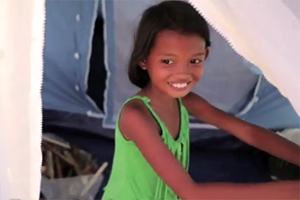
Honeyrea lives in the settlement of Tanuan on Leyte. Credit: Caritas
Imagine the strongest storm you’ve ever known and then multiply it many times over. Imagine winds so powerful that they knock down concrete houses. Imagine shouting prayers at the top of your voice, but not being able to hear what’s coming out of your mouth over the howling wind.
Typhoon Haiyan was one of the strongest storms ever to hit land, with winds of up to 171 miles per hour. But much of the damage on Leyte island was caused by the ‘storm surge’: huge debris-filled waves of water speeding inland, washing away houses, roads and water-supply systems.
When Typhoon Haiyan hit the Philippines in November, ten-year-old Honeyrea was taking shelter in a gymnasium on Leyte island, along with her family and other members of the community. It was an experience she will never forget.
Honeyrea inhabits her delicate frame with a wisdom which seems older than her 10 years. She’s been through a lot – like so many other survivors of Typhoon Haiyan. And she’s learned a lot.
Honeyrea enjoys housekeeping in her temporary home. It’s a large white tent with a dark blue floor, which reflects turquoise light around her as she sweeps with a broom. She is a young girl, playing house, but Honeyrae has also learned the importance of cleanliness in keeping away sickness.
“I wash the dishes, clean inside the tent and the area outside. People from Caritas came to explain to us about how to be super clean to avoid sickness. Now I like living here.”
Honeyrea lives in the settlement of Tanuan on Leyte – her tented community is in the square next to the church and the damaged local school. Honeyrae may not know it, but just through a gate only 100 metres away there is a mass grave for 1 000 people who didn’t survive. It may be tidy around here now, but after the storm, rubbish added to the debris and the latrines were overflowing.
Caritas teams carried out hygiene training as they distributed sanitation kits. Staff encouraged people to maintain the latrines and to collect rubbish. Battered and bruised though they were, the hard-working Filippinos responded quickly. They organised themselves into teams, led by a person known as a captain, whom they elect.
A disaster like Typhoon Haiyan is bad enough in itself, but if survivors don’t have access to clean water and sanitation, diseases like cholera and typhoid can spread extremely quickly – and you can have two disasters in one.

Caritas water bladder. Credit: CAFOD
Caritas brought in a water bladder – an inflatable plastic tank, filled with water – near where Honeyrea and her family were staying Honeyrae’s family draw their water from it. “It tastes sweet and I know I won’t get sick from it. Before, people were starting to fall ill. We know from Caritas that once the sickness takes hold, it is hard to stop it.”
Honeyrae’s school is reopening and she is happy – she wants to be an electrical engineer when she is bigger. She is not recovered from the trauma of Typhoon Haiyan – she’s afraid that people are saying there will be more storms like it. But for now, at least Honeyrae is safe and clean.
Thanks to your donations to our Philippines Typhoon Haiyan appeal, Caritas partners were able to start delivering food, water and emergency supplies within hours of the typhoon striking.
In a country where 80 per cent of the population is Catholic, the Church played a vital role, providing aid quickly in some areas that the Filipino government couldn’t reach for days.
